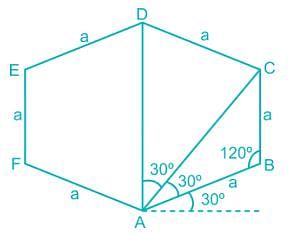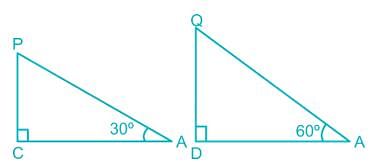Defence Exam > Defence Questions > ABCDEF is a regular polygon. Two poles at C a...
Start Learning for Free
ABCDEF is a regular polygon. Two poles at C and D are standing vertically and subtend angles of elevation 30° and 60° at A respectively. What is the ratio of the height of the pole at C to that of the pole at D?
- a)1 : 1
- b)1 : 2√3
- c)2√3 : 1
- d)2 : √3
Correct answer is option 'B'. Can you explain this answer?
| FREE This question is part of | Download PDF Attempt this Test |
Verified Answer
ABCDEF is a regular polygon. Two poles at C and D are standing vertica...

Suppose the side of the hexagon is ‘a’ unit;
First we need to find out the values of AC and AD;
In triangle ABC, applying the sine rule;
⇒ Sin120/AC = Sin30/BC
⇒ √3/2AC = 1/2a
⇒ AC = a√3 unit
In triangle ACD;
∠ACD = 120 – 30 = 90°
Hence triangle ACD is a right angle triangle;
∴ Sin30 = CD/AD
⇒ ½ = a/AD
⇒ AD = 2a unit

Now in the figure we can see that, CP and DQ are the poles at point C and D and they are subtending 30° and 60° at A respectively;
In triangle ACP;
⇒ Tan30 = PC/AC
⇒ 1/√3 = PC/a√3
⇒ PC = a unit
In triangle ADQ;
⇒ Tan60 = QD/AD
⇒ √3 = QD/2a
⇒ QD = 2a√3 unit
∴ Ratio of the height of the pole at C to that of the pole at D = PC : QD = 1 : 2√3
⇒ Tan30 = PC/AC
⇒ 1/√3 = PC/a√3
⇒ PC = a unit
In triangle ADQ;
⇒ Tan60 = QD/AD
⇒ √3 = QD/2a
⇒ QD = 2a√3 unit
∴ Ratio of the height of the pole at C to that of the pole at D = PC : QD = 1 : 2√3
Most Upvoted Answer
ABCDEF is a regular polygon. Two poles at C and D are standing vertica...
We can conclude that C and D are the vertices of the regular polygon ABCDEF. Since ABCDEF is a regular polygon, all sides and angles are equal.
Let's call the side length of the polygon as s.
Since C and D are vertically standing poles, the angle of elevation from both A and B would be 90 degrees.
Also, since ABCDEF is a regular polygon, the sum of the interior angles is given by (n-2) * 180 degrees, where n is the number of sides of the polygon.
Since ABCDEF is a regular polygon, the sum of the interior angles is also equal to 360 degrees.
Therefore, (n-2) * 180 = 360.
Simplifying the equation, we get (n-2) = 2.
Solving for n, we get n = 4.
So, ABCDEF is a regular polygon with 4 sides, which is a square.
Therefore, the angle of elevation from C and D to any vertex of the square ABCDEF is 30 degrees.
Let's call the side length of the polygon as s.
Since C and D are vertically standing poles, the angle of elevation from both A and B would be 90 degrees.
Also, since ABCDEF is a regular polygon, the sum of the interior angles is given by (n-2) * 180 degrees, where n is the number of sides of the polygon.
Since ABCDEF is a regular polygon, the sum of the interior angles is also equal to 360 degrees.
Therefore, (n-2) * 180 = 360.
Simplifying the equation, we get (n-2) = 2.
Solving for n, we get n = 4.
So, ABCDEF is a regular polygon with 4 sides, which is a square.
Therefore, the angle of elevation from C and D to any vertex of the square ABCDEF is 30 degrees.

|
Explore Courses for Defence exam
|

|
Similar Defence Doubts
ABCDEF is a regular polygon. Two poles at C and D are standing vertically and subtend angles of elevation 30° and 60° at A respectively. What is the ratio of the height of the pole at C to that of the pole at D?a)1 : 1b)1 : 2√3c)2√3 : 1d)2 : √3Correct answer is option 'B'. Can you explain this answer?
Question Description
ABCDEF is a regular polygon. Two poles at C and D are standing vertically and subtend angles of elevation 30° and 60° at A respectively. What is the ratio of the height of the pole at C to that of the pole at D?a)1 : 1b)1 : 2√3c)2√3 : 1d)2 : √3Correct answer is option 'B'. Can you explain this answer? for Defence 2024 is part of Defence preparation. The Question and answers have been prepared according to the Defence exam syllabus. Information about ABCDEF is a regular polygon. Two poles at C and D are standing vertically and subtend angles of elevation 30° and 60° at A respectively. What is the ratio of the height of the pole at C to that of the pole at D?a)1 : 1b)1 : 2√3c)2√3 : 1d)2 : √3Correct answer is option 'B'. Can you explain this answer? covers all topics & solutions for Defence 2024 Exam. Find important definitions, questions, meanings, examples, exercises and tests below for ABCDEF is a regular polygon. Two poles at C and D are standing vertically and subtend angles of elevation 30° and 60° at A respectively. What is the ratio of the height of the pole at C to that of the pole at D?a)1 : 1b)1 : 2√3c)2√3 : 1d)2 : √3Correct answer is option 'B'. Can you explain this answer?.
ABCDEF is a regular polygon. Two poles at C and D are standing vertically and subtend angles of elevation 30° and 60° at A respectively. What is the ratio of the height of the pole at C to that of the pole at D?a)1 : 1b)1 : 2√3c)2√3 : 1d)2 : √3Correct answer is option 'B'. Can you explain this answer? for Defence 2024 is part of Defence preparation. The Question and answers have been prepared according to the Defence exam syllabus. Information about ABCDEF is a regular polygon. Two poles at C and D are standing vertically and subtend angles of elevation 30° and 60° at A respectively. What is the ratio of the height of the pole at C to that of the pole at D?a)1 : 1b)1 : 2√3c)2√3 : 1d)2 : √3Correct answer is option 'B'. Can you explain this answer? covers all topics & solutions for Defence 2024 Exam. Find important definitions, questions, meanings, examples, exercises and tests below for ABCDEF is a regular polygon. Two poles at C and D are standing vertically and subtend angles of elevation 30° and 60° at A respectively. What is the ratio of the height of the pole at C to that of the pole at D?a)1 : 1b)1 : 2√3c)2√3 : 1d)2 : √3Correct answer is option 'B'. Can you explain this answer?.
Solutions for ABCDEF is a regular polygon. Two poles at C and D are standing vertically and subtend angles of elevation 30° and 60° at A respectively. What is the ratio of the height of the pole at C to that of the pole at D?a)1 : 1b)1 : 2√3c)2√3 : 1d)2 : √3Correct answer is option 'B'. Can you explain this answer? in English & in Hindi are available as part of our courses for Defence.
Download more important topics, notes, lectures and mock test series for Defence Exam by signing up for free.
Here you can find the meaning of ABCDEF is a regular polygon. Two poles at C and D are standing vertically and subtend angles of elevation 30° and 60° at A respectively. What is the ratio of the height of the pole at C to that of the pole at D?a)1 : 1b)1 : 2√3c)2√3 : 1d)2 : √3Correct answer is option 'B'. Can you explain this answer? defined & explained in the simplest way possible. Besides giving the explanation of
ABCDEF is a regular polygon. Two poles at C and D are standing vertically and subtend angles of elevation 30° and 60° at A respectively. What is the ratio of the height of the pole at C to that of the pole at D?a)1 : 1b)1 : 2√3c)2√3 : 1d)2 : √3Correct answer is option 'B'. Can you explain this answer?, a detailed solution for ABCDEF is a regular polygon. Two poles at C and D are standing vertically and subtend angles of elevation 30° and 60° at A respectively. What is the ratio of the height of the pole at C to that of the pole at D?a)1 : 1b)1 : 2√3c)2√3 : 1d)2 : √3Correct answer is option 'B'. Can you explain this answer? has been provided alongside types of ABCDEF is a regular polygon. Two poles at C and D are standing vertically and subtend angles of elevation 30° and 60° at A respectively. What is the ratio of the height of the pole at C to that of the pole at D?a)1 : 1b)1 : 2√3c)2√3 : 1d)2 : √3Correct answer is option 'B'. Can you explain this answer? theory, EduRev gives you an
ample number of questions to practice ABCDEF is a regular polygon. Two poles at C and D are standing vertically and subtend angles of elevation 30° and 60° at A respectively. What is the ratio of the height of the pole at C to that of the pole at D?a)1 : 1b)1 : 2√3c)2√3 : 1d)2 : √3Correct answer is option 'B'. Can you explain this answer? tests, examples and also practice Defence tests.

|
Explore Courses for Defence exam
|

|
Signup for Free!
Signup to see your scores go up within 7 days! Learn & Practice with 1000+ FREE Notes, Videos & Tests.


















